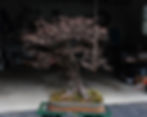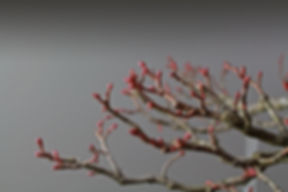

Deciduous
01. Trident Maple
This maple was acquired in the fall of 2018 from my good friend Judy Barto. It was originally grown from a cutting taken from a tree that was imported from Japan. It was field grown for many years until it was dug up and subsequently developed in large plastic tubs. Don Blackmond and later Judy, both did great work in setting this tree for future success as a bonsai. Since it came to the garden in 2018, I have continued to further develop, improve and refine this massive trident.
This maple stands 27" tall from the edge of the container with a root spread of 15" above soil. Taiwanese pot hand crafted and painted by Xing Rong Yi.
Please click on the image to enlarge and obtain further information about this tree.
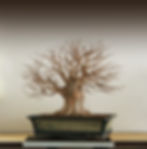
February 2014. The front was shifted slightly clockwise so the pot appears crooked in the photo. In the next repotting in the spring of 2025 it will be reset. For the most part the overall volume of the canopy has been reached. The focus now will be continuing to improve the fine ramification.

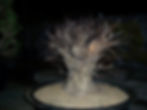
Back Don Blackmond had the trident in his nursery in 2009. During this period the tree was being developed in large plastic pots.

February 2014. The front was shifted slightly clockwise so the pot appears crooked in the photo. In the next repotting in the spring of 2025 it will be reset. For the most part the overall volume of the canopy has been reached. The focus now will be continuing to improve the fine ramification.
02. Linden
Linden (Tilia Cordata) is native to and widespread throughout much of Europe. This tree came originally from Randy Knight. Jason Gamby did much of the initial work with Walter Pall. In 2010 it came under the care of Ryan Neil who further developed it and eventually featured it in two of Mirai's live streams. In 2018 I purchased the tree and is now part of the M5 Bonsai Works permanent collection.
This tilia has a massive trunk with exceptional bark quality that contrast beautifully with the winter wine red buds. Extremely hardy and durable species that endures well the hardships of winter. The heart-shaped leaves attain a clear canary yellow in autumn.
This tree stands 22" from soil level. Container is by Horst Heinzlreiter, Germany.
Please click on the image to enlarge and obtain further information about this tree.
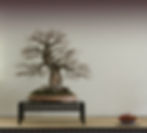


Ryan Neil seen here working the tilia in a Mirai live stream in 2018. In this live stream he made some big design decisions that change the course of this tree. He discussed opening up the canopy, creating a more asymmetrical design that is typical of old trees in nature.

Arakawa maples are a classic bonsai subject. Their beautifully textured bark with their brilliant spring and autumn color makes this variety an exceptional choice. I have been working with this tree for several years now, slowly building a well ramified canopy and continuously improving the nebari through a series of root grafts. Arakawa are quite resistant to leaf burn and stand up well even after spending a whole season under the hot sun. This particular specimen is unusual in the fact that its spring leaves are red in contrast to most arakawa maples that are green. This tree has appeared in International Bonsai Magazine issue# 3, 2020.
This tree stands 26" tall from soil level. Container by Nao Tokutake, USA.
Please click on the image to enlarge and obtain further information about this tree.
03. Japanese Maple 'Arakawa'
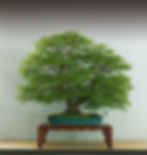
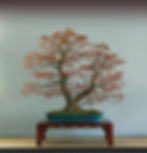

Spring 2013. The tree shortly after purchase.

04. Japanese Maple Kashima
This kashima maple was originally purchased from Suthin Sukolsovisit who had imported the tree from Japan many years ago. Kashima fall under the yatsubusa group of maples with beautiful small leaves that have a distinctive orange cast in spring. Due to an overwintering mishap, the tree suffered greatly and most of it died back in early spring 2011. Since then, I have been rebuilding the entire tree with a new and more compact canopy. Kashima maples are basally dominant so one must keep lower areas in check to prevent the apex from weakening.
This maple is 16" tall from soil level. Container is by Yamafusa, Japan.
Please click on the image to enlarge and obtain further information about this tree.
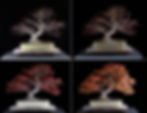
Spring 2017 budding sequence. The maple keeps progressing well with more intricate ramification taking place. The top third in particular needs more development.

Summer 2011

Before and after. It has come a long way!

Spring 2017 budding sequence. The maple keeps progressing well with more intricate ramification taking place. The top third in particular needs more development.
Sharp's Pygmy maples are considered to be a dwarf cultivar and as such they produce small leaves and short internodes making it an ideal subject for bonsai. The leaves are deeply incised that are a bright chartreuse green in early spring giving way to an intense red and orange color in the fall.
This tree was honored with the "FINEST DECIDUOUS BONSAI" award at the 4th US National Bonsai Exhibition in 2014. It was also featured in Bonsai Focus magazine #138/161. In addition, Bonsai Bark did a write-up with a link to a 360 seasonal transformation movie I made in collaboration with Maximiliano Barros: "Spinning through the Seasons".
It stands 28" from soil level. Container is by Reiho, Japan.
Please click on the image to enlarge and obtain further information about this tree.
05. Japanese Maple Sharp's Pygmy
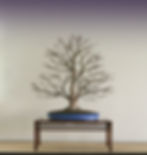
As it happens sometimes, the back of the tree has become the new front. Some parts of the tree needed to be wired again to better conform to the tree's new front.

The nebari has significantly improved in the past few years. December 2023.
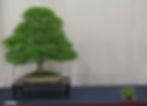
The maple as displayed at the 4th US National, September 2014. Shortly before the exhibit, the tree was taken out and repositioned within the container. A risky move to do in late summer. The decision paid off with the tree winning "FINEST DECIDUOUS BONSAI" at the exhibit.

As it happens sometimes, the back of the tree has become the new front. Some parts of the tree needed to be wired again to better conform to the tree's new front.
06. Japanese Maple
I obtained this tree as a piece of well developed stock from Karen Proctor in Rochester, NY back in 2009. Eventually I sought to improve the overall design by air layering one of its lower branches and then grafted it at the base to create a twin trunk bonsai. I have also improved the nebari with root grafts with perhaps more to come in the future. This tree was featured in an article in International Bonsai Magazine 2015 issue#2 with a detailed account of how it was created.
This bonsai is 30" high from soil level. Container is by Mazan, Japan.
Please click on the image to enlarge and obtain further information about this tree.
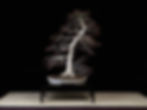

Detail, January 2019.
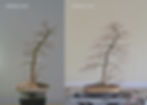
Before and after. The image on the left shows the maple with its recently grafted second trunk and a whip used for a root graft on the left side of the nebari.

07. Japanese Maple 'Kiyo-hime'
This maple was acquired from Suthin Sukosolvisit in 2007. It was originally created as an informal upright shohin bonsai. In late winter of 2014 the tree suffered extensive dieback due to an overwintering error with only the main branch surviving the incident. It was then decided to turn it into a cascade style bonsai in an effort to salvage what was left of it. Last year it was yet again re-envisioned as a root-over-rock design.
This maple stands 12" high from soil level. Container is by Michael Murphy, USA.
Please click on the image to enlarge and obtain further information about this tree.


January 2024. The tree is displayed here on a beautiful custom made stand by Alex Imbo.


08. Japanese Beech Forest
Originally imported from Japan, this Japanese white beech forest eventually became part of the famous Kennett Collection in Kennett, PA. I purchased this bonsai at the highly anticipated Kennett Collection sale event that was held at the Gateway Garden Center in Delaware. Originally what was intended to be the back of the forest I used as the new front. The trees have a beautiful white bark that is striking specially in winter. It was accepted and shown at the 6th US National on September 2016. A few months later, on December 2016, this tree was honored with the "BEST IN SHOW" award at the Winter Silhouette Bonsai Expo in Kannapolis, NC.
This bonsai stands 26" tall from the base of the trees with a 36" wide canopy. Planted in a granite slab.
Please click on the image to enlarge and obtain further information about this tree.
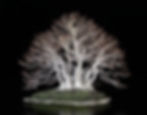


The beech forest (lower center) during the Kennett sale held at the Gateway Garden Center in Delaware. Photo courtesy of Capital Bonsai.

09. European Copper Beech
This tree was originally created by Bill Valavanis. Many years later, it was acquired in a trade with my good friend and talented bonsai practitioner Judy Barto. European beech (Fagus sylvatica) tend to be easier than Japanese beech (Fagus crenata) in their care. It responds readily to horticultural techniques thanks to their vigor. They can bud back with relative ease as long as correct timing is chosen in applying various techniques. A tall, quiet and elegant tree with striking spring and autumn coloration. It is most appreciated it in winter with its delicate, airy character and light gray bark.
Tree stands 32" high from soil level. Container is by Yamafusa, Japan.
Please click on the image to enlarge and obtain further information about this tree.
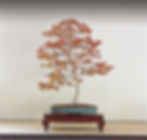
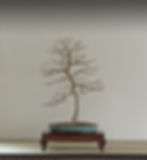


10. Silver Birch
This birch was acquired in 2020 from Eric Schrader, a well known bonsai professional in the Bay Area. Eric started this tree from a young seedling. It was then field grown for several years and later further developed in containers. The tree was built with an interesting branch structure with and up and down movement to the branches making the design more interesting and less predictable. They are notorious for branch dieback and so timing of pruning, watering and light exposure need to be carefully considered. They are highly prized for their smooth white bark contrasting with highly textured areas such as seen in this specimen.
This birch stands 25" tall from soil level. Container is Japanese, unknown artist.
Please click on the image to enlarge and obtain further information about this tree.
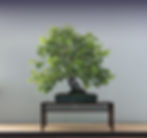
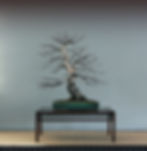
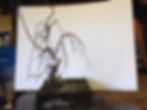
An early photo from circa 2013. The tree was originally designed by Eric as a weeping bonsai. Later he changed his mind.

11. Japanese beech
This Japanese beech was originally a single trunk tree grown for many years by Julian Adams and was purchased in 2017.
This tree stands 26" from the bottom of the stone. Planted on a Japanese Ibigawa stone.
Please click on the image to enlarge and obtain further information about this tree.

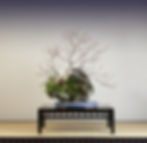
October 2023. The tree has been growing quite well and the ramification improving year by year. The left to right movement is emphasized by the elongating lower right branch.

A few ferns along with some other plants such as selaginella were added to create a naturalistic image.

12. Zelkova Serrata
This zelkova shohin originally imported from Japan, is designed in the traditional formal broom style. I continue to develop its nebari and further increase the density of its ramification.
This tree stands 7" from soil level. Container is Japanese by Aiba Koyo.
Please click on the image to enlarge and obtain further information about this tree.
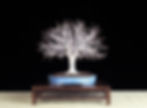
November 2022. Now shown paired with a beautiful Koyo pot.


December 2017. The tree's small size makes for a very charming image.

November 2022. Now shown paired with a beautiful Koyo pot.
13. Yatsubusa Elm
This Yatsubusa elm (Ulmus parvifolia 'Yatsubusa') was acquired in May 2017 directly from Ryan Neil at Mirai. A very old tree that had been grown for propagation purposes for many decades in the Wyllamette Valley, Oregon. After the land was sold to a developer, Ryan stepped in and purchased some of these old trees with the intent of making them into bonsai. One of its most striking features is the incredibly fissured bark. Along with it, the tiny dark green leaves and fine ramification impart a very believable scale to the image it presents as a bonsai.
This tree stands 43" from soil level. Container by Nao Tokutake, USA
Please click on the image to enlarge and obtain further information about this tree.
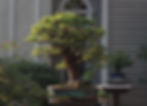

The refinement of the ramification has and continues to improve greatly.
